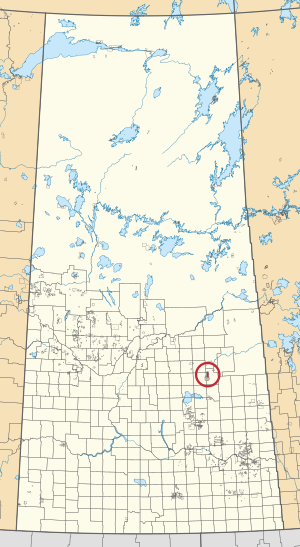Yellow Quill 90 facts for kids
Quick facts for kids
Yellow Quill 90
|
|
|---|---|
| Yellow Quill Indian Reserve No. 90 | |

Location in Saskatchewan
|
|
| First Nation | Yellow Quill |
| Country | Canada |
| Province | Saskatchewan |
| Area | |
| • Total | 5,858.8 ha (14,477.4 acre) |
| Population
(2016)
|
|
| • Total | 436 |
| Community Well-Being Index | 45 |
Yellow Quill 90 is a special place called an Indian reserve in Saskatchewan, Canada. It is home to members of the Yellow Quill First Nation. This reserve is located about 19 kilometers (which is about 12 miles) northwest of a town called Kelvington.
Contents
Yellow Quill 90: A First Nation Community
Yellow Quill 90 is one of the many Indian reserves across Canada. These lands are set aside for the use and benefit of First Nations people. The Yellow Quill First Nation is a self-governing community. They work to preserve their culture, traditions, and way of life.
Where is Yellow Quill 90 Located?
Yellow Quill 90 is found in the Canadian province of Saskatchewan. Saskatchewan is known for its wide-open prairies and big skies. The reserve is in a rural area, meaning it's away from big cities. It's about 19 kilometers (12 miles) northwest of the small town of Kelvington. This location helps the community stay connected to nature and their traditional lands.
Who Lives in Yellow Quill 90?
In 2016, a count of people called a census was done in Canada. This census showed that 436 people lived on Yellow Quill 90. These people lived in 110 homes out of 121 total houses on the reserve. This means that most of the homes were occupied. The community is a close-knit group of people.
Understanding Community Well-Being
The Community Well-Being Index is a way to measure how well a community is doing. It looks at things like health, education, income, and housing. The index gives a score out of 100. In 2016, Yellow Quill 90 had a score of 45.
- This score can be compared to other communities.
- The average score for First Nations communities was 58.4.
- The average for non-Indigenous communities was 77.5.
This index helps people understand the different challenges and strengths of communities. It shows areas where support and improvements might be needed. It helps leaders make decisions to improve life for everyone in the community.

